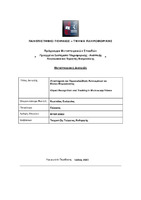Αναγνώριση και παρακολούθηση αντικειμένων σε βίντεο μικροσκοπίας
Object recognition and tracking in microscopy videos

Προβολή/
Λέξεις κλειδιά
Tracking ; Bioimaging ; Image analysis ; VideoΠερίληψη
Η αυτόματη αναγνώριση και παρακολούθηση αντικειμένων σε ακολουθίες εικόνων είναι μια εφαρμογή της ανάλυσης εικονας που έχει δει πολύ μεγάλη άνθηση και αποτελεί εδώ και χρόνια σημαντικό αντικείμενο έρευνας. Ενδεικτικό είναι πως η αναζήτηση των όρων image tracking στο pubmed επιστρέφει 11,404 δημοσιεύσεις για τα έτη 1959-2010 και 36,693 δημοσιεύσεις από το 2011 μέχρι σήμερα.
Υπάρχει όπως θα δούμε παρακάτω εξαιρετικά μεγάλος αριθμός μεθόδων και αλγορίθμων για την διαδικασία αυτή, γεγονός που γίνεται εύκολα κατανοητό αν λάβουμε υπόψη οτι η αναγνώριση και ο εντοπισμός αντικειμένων από δεδομένα εικόνας έχουν βρεί εφαρμογή σε πάρα πολλούς διαφορετικούς κλάδους, όπως η αστρονομία, η βιολογία, η ιατρική, η ρομποτική, κα. Οι κλάδοι αυτοί όμως εργάζονται με τελείως διαφορετικά είδη εικόνας και συμπεριφοράς των αντικειμένων, πράγμα που συνεπάγεται την ανάγκη για διαφορετικές μεθοδολογίες ανάλυσης.
Ο μεγάλος αριθμός μεθοδολογιών που προκύπτει, σε συνδυασμό με το γεγονός πως οι άνθρωποι στους οποίους χρειάζεται να τις εφαρμόσουν, σπάνια είναι ειδικοί στην ανάλυση εικόνας και τον προγραμματισμό, αλλά σε τελείως διαφορετικούς κλάδους, κάνει την εφαρ- μογή τέτοιων μεθόδων δυσπρόσιτη και περιορίζει την δυνατότητα εφαρμογής τους.
Συγκεκριμένα στην βιολογία, που είναι και το αντικείμενο της παρούσας εργασίας, η πρόοδος των τεχνικών μέσων απόκτησης και αποθήκευσης εικόνων αλλά και η μετασ- τροφή του ερευνητικού ενδιαφέροντος, από την καθαρή γενετική στην μελέτη ολόκληρου του περιβάλλοντος στο εσωτερικό των έμβιων οργανισμών έχει φέρει την ανάγκη για καλύτερες και πιο προσιτές τεχνικές αυτόματης ανάλυσης εικόνας στο προσκήνιο του ερευνητικού εν- διαφέροντος.
Σκοπός αυτής της εργασίας είναι να γίνει μια συνοπτική παρουσίαση κάποιων από τις βασικότερες μεθοδολογίες ανάλυσης εικόνας, εντοπισμού και παρακολουθησης αντικειμένων σε ακολουθίες εικόνων, με έμφαση στις τεχνικές που βρίσκουν εφαρμογή στην Βιολογία. Στη συνέχεια παρουσιάζουμε ένα πρόγραμμα, το οποίο έχει σκοπό την απλοποίηση και την αυτοματοποίηση εφαρμογής αυτών των μεθόδων σε μία προσπάθεια να γίνουν προσιτές σε ανθρώπους χωρίς ιδιαίτερες γνώσεις στον προγραμματισμό ή την ανάλυση εικόνας.

